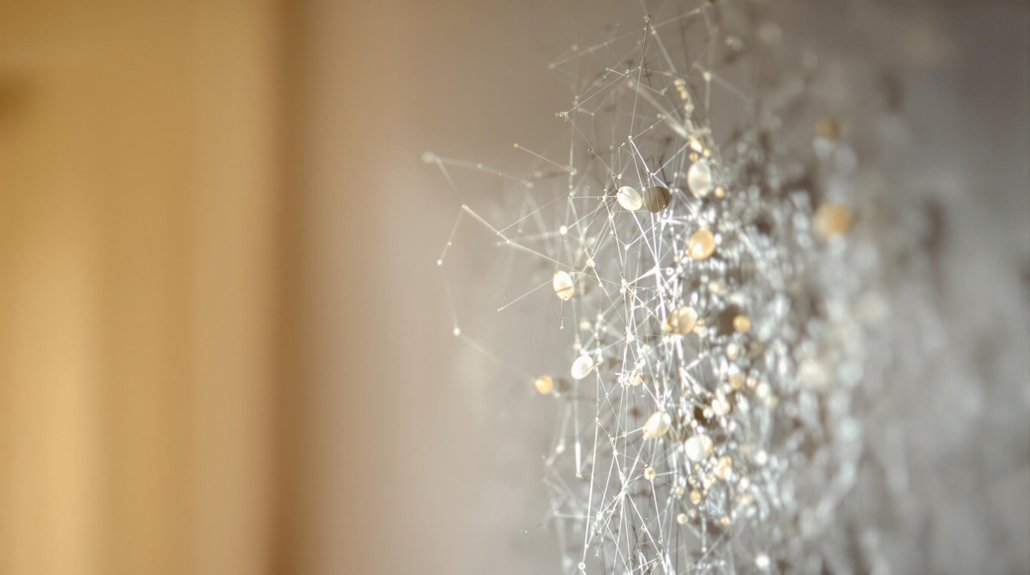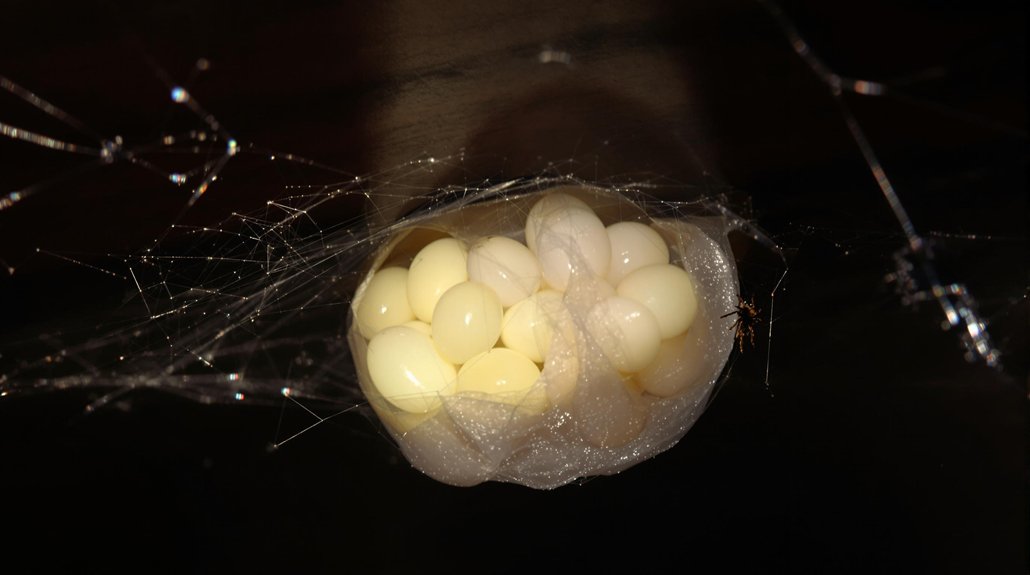Signs a spider has laid eggs include tiny silk sacs found in hidden areas like corners or behind furniture. Increased spider activity or more frequent sightings can also indicate nearby eggs. Unusual web patterns or clusters of small eggs stuck to surfaces are common clues. You may notice shed skins or tiny spiderlings hinting eggs have recently hatched. Recognizing these signs early helps manage an infestation. If these details sound familiar, you can discover more by examining these signs closely.
Key Article Highlights
- Look for tiny silk sacs, often hidden in corners or behind furniture.
- Notice increased spider activity or sightings around specific spots.
- Observe unusual web patterns, tangled or layered webs indicating spider presence.
- Check for small silk threads or egg sacs glued to walls, furniture, or cracks.
- Spot shed skins or signs of recent hatching, such as small spiderlings nearby.
Signs of Tiny Silk Sacs in Hidden Corners

Tiny silk sacs are often the first sign that a spider has laid eggs in a room. These sacs are usually found in hidden corners, behind furniture, or tucked away in less visible areas. Spiders create hidden nests where they deposit their eggs, often concealed by layers of silk. Look for small, round silk sacs that are about the size of a pea or smaller. Additionally, silk trails may be present nearby, indicating the spider’s movement within the space. These silk trails are thin, sticky threads that spiders use to navigate and anchor their nests. Recognizing these signs early can help identify the presence of spider eggs before they hatch. Regular inspection of hidden corners and areas with silk trails is essential for early detection.
Increased Spider Activity and Sightings
People may notice more spiders in their room than usual. There can be a sudden increase in spider sightings or more spiders appearing over time. These signs can indicate that a spider nest or eggs are nearby.
More Frequent Sightings
Spiders tend to become more visible in a room when their activity increases. This often results from changes in spider behavior, such as searching for food or suitable sites for egg-laying. An increase in sightings may also be linked to room cleanliness; cluttered spaces provide more hiding spots and attract insects, which in turn draw spiders. When spider activity becomes more frequent, it suggests they are establishing a presence, possibly indicating eggs are nearby. Regularly monitoring your room for spider signs is essential. Maintaining cleanliness and reducing clutter can help limit spider activity. If sightings persist or increase, it may be a sign of a developing spider nest or egg sac, requiring further inspection and removal. Understanding these patterns helps in early detection of spider eggs.
Sudden Increase in Spiders
A sudden increase in spider activity and sightings often indicates a nearby egg sac or growing colony. Different spider species tend to reproduce in specific environments, so an uptick in sightings may signal their presence. Poor room cleanliness can attract spiders by providing hiding spots and food sources like other insects. When the room becomes cluttered or dusty, it creates a favorable environment for spiders to settle and reproduce. An increase in spider sightings across a short period suggests that an egg sac may have been laid, and hatchlings are emerging. Regular cleaning and reducing clutter can help monitor and control spider presence. Recognizing these signs allows for early intervention, preventing a larger infestation and ensuring a spider-free space.
Unusual Web Patterns in Your Room
Unusual web patterns in a room can indicate the presence of a spider or its activity. These patterns often differ from common spider webs, displaying complex or irregular designs. The web design may include tangled or layered structures, suggesting the web material was added over time or repaired. Some spiders create extensive, sprawling webs that seem unusual compared to typical orb webs. Others may produce irregular, messy webs that do not follow standard patterns. Observing these web designs can help identify spider activity and determine if eggs might be nearby. The web material can also reveal clues, such as silk that appears thicker or sticky in specific areas. Recognizing these signs allows for better understanding of spider behavior and potential egg-laying sites in the room.
Small, Unexplained Egg Clusters
Small, unexplained egg clusters can sometimes be seen in a room. These clusters are often accompanied by nearby webs or silk. Noticing these signs may indicate the presence of spider eggs.
Visible Egg Clusters
Visible egg clusters can often be identified by their small, compact groups of eggs found in hidden or overlooked areas around a room. These clusters are typically easy to spot once known what to look for. Recognizing egg cluster characteristics, such as shape, size, and color, helps confirm their identity.
Key egg identification techniques include inspecting dark corners, behind furniture, or near clutter. Look for:
- Small, rounded groups of eggs tightly packed together
- Clusters attached to surfaces like walls, ceilings, or objects
- Eggs that are pale or whitish in color and uniform in size
Noticing these features can help determine if a spider has laid eggs in the room. Early detection allows for proper handling and removal before hatching occurs.
Nearby Webs or Silk
Nearby webs or silk can indicate the presence of spider eggs in a room. The web location often provides clues about where eggs may be laid. Spiders tend to build webs in corners, behind furniture, or on ceiling edges. The silk texture can also reveal information; freshly spun silk is usually smooth and shiny, while older silk may appear dull or brittle. Small, unexplained egg clusters are sometimes found attached to the silk within these webs. If webs are concentrated in a particular area and contain small silken sacs or clusters, it suggests the presence of spider eggs. Regularly inspecting web locations and noting changes in silk texture can help identify whether eggs are nearby. This awareness aids in early detection and control.
Changes in Spider Behavior or Movement
When a spider lays eggs, its behavior and movement patterns often change noticeably. The spider may become more cautious, moving less frequently or avoiding certain areas. Its activity level can decrease, as it focuses on protecting its eggs. Sometimes, the spider may stay near a specific spot for long periods. Changes in spider behavior can include reduced movement or hiding more often. Movement patterns may also shift, with the spider staying close to its egg sac or web. Observing these signs can help identify if eggs are present.
- The spider remains near a particular area for extended periods
- It moves slowly or cautiously compared to usual
- It reduces activity and hides more often
These changes are signs of a spider protecting its future offspring.
Detecting Faint Egg Residue or Silk Residue

Detecting faint egg residue or silk residue involves examining surfaces carefully for subtle signs of silk threads or small, sticky patches that may indicate eggs. Look for tiny, shiny silk strands with a silk texture that differ from the surface. Egg color can vary from white to yellowish, often blending with surroundings. Residue may appear as faint, sticky spots or silk fragments on walls, furniture, or corners. Using a flashlight can help reveal these subtle signs. Check frequently, especially in hidden places.
| Surface Type | Sign to Look For | Observation Tips |
|---|---|---|
| Walls | Small silk threads, sticky patches | Use a flashlight for clarity |
| Furniture | Egg residue, silk fragments | Gently brush surface |
| Corners/Cracks | Silk silk, faint residue | Inspect with magnifier |
Presence of Newly Hatched Spiderlings
The presence of newly hatched spiderlings can often be identified by small, moving dots in hidden or dark areas of a room. The tiny spiderlings exhibit specific behavior, such as clustering or moving quickly across surfaces. Recognizing spiderling behavior is essential for accurate spiderling identification.
Signs to look for include:
- Small, rapidly moving dots that resemble dust particles but are actually spiderlings
- Clusters of tiny creatures near silk webs or egg sacs
- Movement in dark corners, behind furniture, or within cracks
These behaviors help distinguish spiderlings from dust or other debris. Noticing these signs indicates recent hatching, which can suggest a nearby egg sac. Correct spiderling identification aids in determining if further action is necessary.
Unfamiliar or Persistent Spider Infestation
Unfamiliar or persistent spider infestations can be difficult to identify early, especially if the spiders are hidden or appear suddenly in large numbers. Different spider species may invade a room without obvious signs, making it hard to determine the cause. When an infestation persists despite cleaning efforts, it suggests that the spiders have established a new habitat or breeding site. Such infestations often require targeted infestation control methods, including sealing entry points and removing webs. Recognizing these signs early helps prevent an increase in spider populations. Understanding the behavior of various spider species is essential for effective control. Persistent infestations indicate a need for more thorough measures to eliminate the spiders and their eggs, ensuring the space remains spider-free.
Visual Clues on Furniture and Walls

Websites and walls often show clear signs of a spider’s presence through small silk threads, egg sacs, and shed skins. During furniture inspection, look closely for tiny silk strands attached to furniture edges or corners. Wall examination can reveal small, whitish egg sacs glued to surfaces or hidden in cracks. These clues indicate that a spider may have laid eggs nearby.
Key signs to watch for include:
- Tiny silk webbing on furniture or wall corners
- Small, round egg sacs attached to surfaces
- Shed skins left behind after molting
Regular inspection of furniture and walls helps detect early signs of egg-laying. Recognizing these visual clues is essential for effective control and prevention of a spider infestation.





